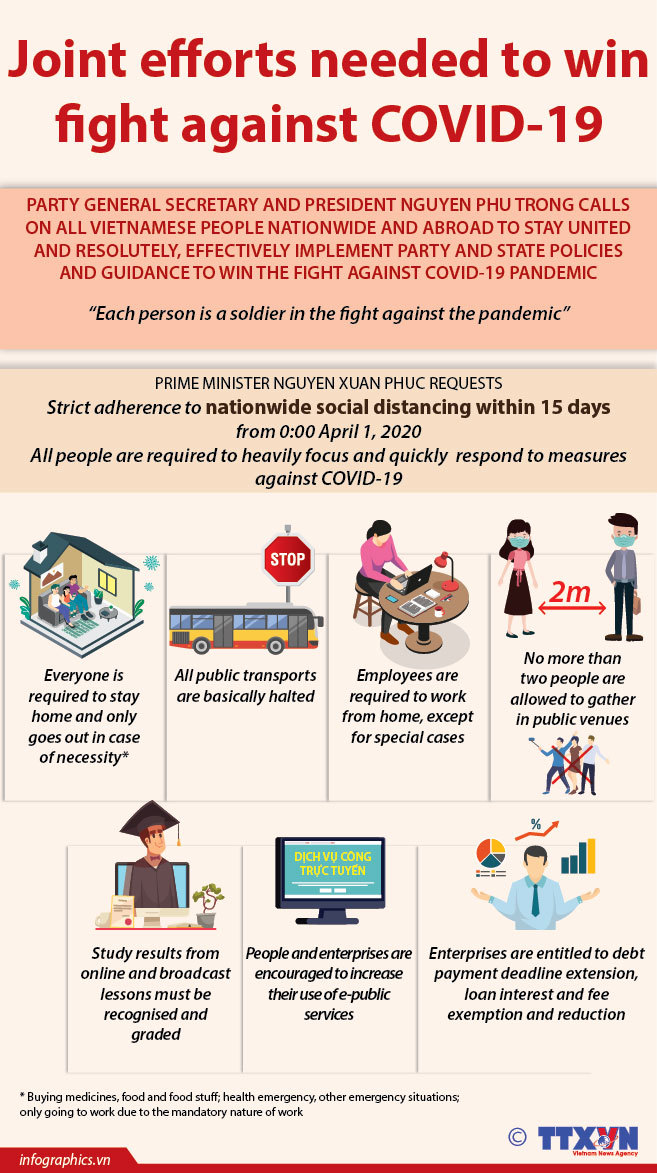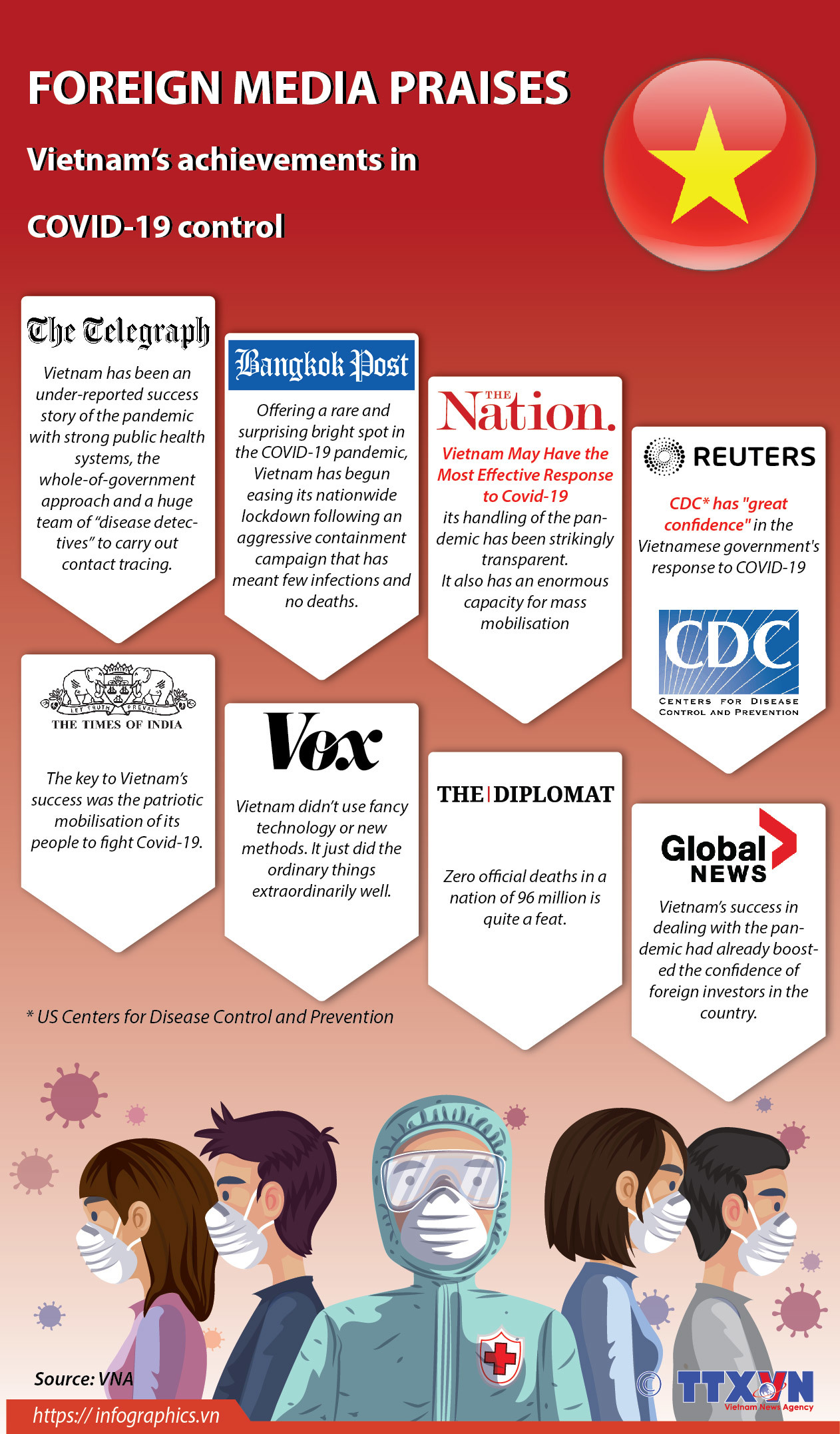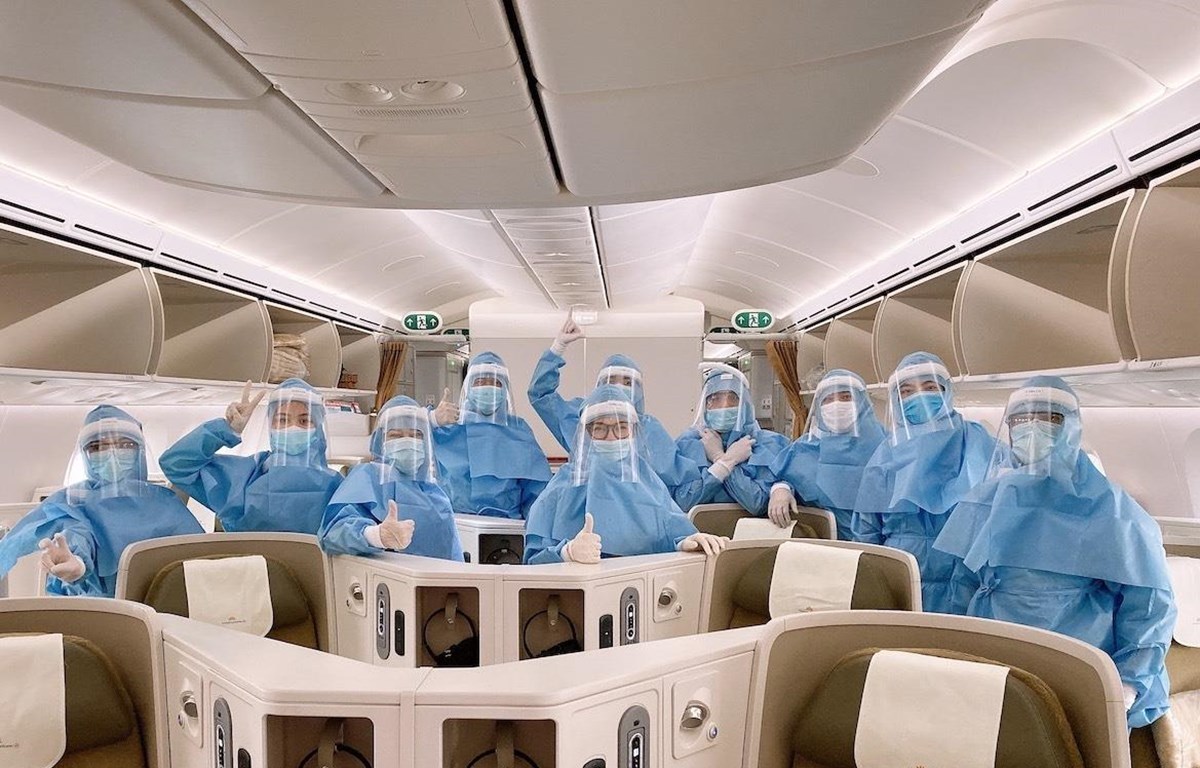Vietnamese people nationwide are now back to the “new normal”.
The coronavirus disease (COVID-19) caused by the severe acute respiratory syndrome coronavirus 2 (SARS-CoV-2) first emerged in Wuhan, China, last December. The outbreak quickly became a global threat, spreading to hundreds of countries and territories around the world. Many countries were forced to close their borders, suspend flights, and impose curfews to curb the spread of the virus.
The outbreak hit Vietnam early on. In late January, a Chinese man from Wuhan passed the coronavirus on to his Vietnam-based son. Vietnam was considered to be among the countries most vulnerable to the outbreak, given it shares a 1,430-km border with China where travel and trade are brisk and has a large population of 97 million people. It quickly recognised the severity of the threat, however, and took prompt action and devised timely measures to prevent the spread of COVID-19.
Vietnam had reported 324 cases of COVID-19 infections as at May 18, or just under three cases per million people - among the lowest rates in the world. Notably, 264 COVID-19 patients, or more than 80 percent of infections, have recovered and been discharged from hospital, and fatalities stand at zero. The key to such impressive achievements include the determination and active involvement of the Party, the State, and the Government, effective control and prevention measures, and social consensus and support.
 |
| Vietnam stands firm amid Covid-19 outbreak |
Strong political determination
While people across Vietnam were celebrating the traditional Lunar New Year (Tet) in late January, the Politburo along with the Secretariat of the Party Central Committee, the National Assembly, and the Government had already recognised COVID-19 as an urgent problem and mobilised the entire political system to deal with the threat.
On January 27 (the third day of Tet), Prime Minister Nguyen Xuan Phuc declared at a Government meeting that a fight against coronavirus was looming, as the virus had emerged from China and “will soon spread to Vietnam,” he said.
With a spirit of “prevention is better than cure”, the Prime Minister emphasised that “fighting the pandemic is like fighting an enemy”, “some economic benefits must be sacrificed to best protect the health and lives of the people”, and “no one will be left behind.”
This declaration has since been praised by international media for its soundness, decisiveness and bravery, saying that early warnings and the implementation of strong prevention and control measures – more drastic than those recommended by the World Health Organisation (WHO) – right at the beginning helped Vietnam effectively control the spread of the virus in the community.
The international media has repeatedly mentioned the slogan “Let’s fight the pandemic as if fighting an enemy”, which aroused national awareness and solidarity.
John MacArthur, the country representative of the US Centers for Disease Control and Prevention’s in neighbouring Thailand, praised Vietnam’s response and attributed it to the country’s political commitment early on at the highest level. “And that political commitment went from the central level all the way down to the hamlet level,” he noted.
Meanwhile, The Diplomat, one of the leading journals in international politics, devoted many pages to praising Vietnam’s anti-pandemic work. Some articles said through preventive measures, the Communist Party of Vietnam has affirmed its leadership role.
Russia’s Sputnik news agency, meanwhile, ran an article saying that the declaration of a nationwide epidemic when the number of new COVID-19 cases exceeded 200 proved that the Vietnamese Government had acted at the right time. Moroccan media outlet Hespress commented that Vietnam’s success laid in quickly recognising the crisis and immediately announcing it to the public.
 |
Effective preventive measures
In mid-January, Prime Minister Phuc issued a warning about the spread of COVID-19 and called on every Vietnamese citizen to be ready to cope with the outbreak.
Vietnam quickly established the National Steering Committee for COVID-19 Prevention and Control and created response scenarios at different levels while devising and effectively implementing the consistent principles of prevention - detection - quarantine - localisation (zoning off pandemic-hit areas) - stamping out the disease, and the “four on-site” motto: on-site leadership, on-site forces, on-site resources, and on-site logistics.
Kidong Park, WHO Representative in Vietnam, greatly appreciates the “four on-site” motto, saying it helped the country respond quickly and reduced overload at centrally-run hospitals.
Social distancing was the next firm measure the Government adopted when the country detected a source of cross-infection within the community. With the instruction of staying inside the locality and at home, social distancing helped minimize the movement of people and limited gatherings - the basic causes of the rapid spread of the disease and which placed many countries in a severe situation from which they are yet to emerge.
Former Head of the Department of Preventive Medicine Tran Dac Phu said that instead of conducting massive tests, Vietnam shifted its focus to quarantining patients and retracing their steps to determine with whom they had been in contact.
“Massive testing is good, but it depends on the resources of each country,” he said. “It is important to identify who may have been in contact with an infected individual or who has returned from an area hit by the epidemic.”
In addition to the thorough search for those who had contact with COVID-19 patients, Vietnam also set up concentrated quarantine areas with support from medical students and retired health workers. “Vietnam is a mobilisation society,” said Carl Thayer, Professor Emeritus at the University of New South Wales. “It is a one-party state; it has large public security forces, the military, and the Party itself; and it’s a top-down government that’s good at responding to natural disasters.”
One of the secrets behind Vietnam’s initial success in slowing the spread of the virus was clear communication and information transparency, together with strong technological support. The Government used social media and information technology to promote information on fighting COVID-19, provide the latest information on the outbreak as well as preventive measures for adoption, and quickly rectify information that proved to be false, while systematically collecting information and identifying suspected COVID-19 clusters as quickly as possible.
Widespread public consensus
It is clear that Vietnam has successfully controlled the disease by this time, due to its strategy of mobilising society as a whole, including the army, security forces, authorities at all levels, and individuals to become involved in the battle against COVID-19 - similar to its history of fighting colonialism and imperialism.
The broad public consensus was what German financial adviser in Vietnam, Manuel Wendle, mentioned often in an interview with Germany’s Die Oberbadische newspaper when asked about the factors that helped Vietnam successfully control the outbreak.
According to Wendle, Vietnam found public consensus on epidemic prevention and control measures, he said, which were then undertaken from the grassroots to the central level.
Though such measures could not simply be adopted in other countries, Vietnam proved that if political decisions are widely welcomed by the public then epidemic prevention and control measures will be successful, he added.
Vietnam is not the most powerful country in the world but in the fight against COVID-19 it secured among the highest levels of trust from its citizens. With an index score of 77, Vietnam has been ranked second globally and first in Southeast Asia in terms of its people’s satisfaction with the Government’s response to COVID-19, according to a recently-released study of over 23 countries and territories by the Singapore-based social research agency Blackbox Research and the Toluna Company.
Ninety-four percent of Vietnamese people feel that keeping the public informed about the pandemic worked in managing the disease, according to the study, contributing to the country’s excellent performance.
David Black, Founder and CEO of Blackbox Research, said Vietnam’s impressive score reflects the country’s swift and strict measures to clamp down on the spread of the virus as well as its regular and transparent communications with the public on ongoing investigations.
“Vietnam’s effectiveness in curbing the spread of the virus led to a heightened level of trust and confidence among its citizens in their leaders, especially when we compare the country with some of its Southeast Asian neighbours, who have at times struggled with testing, contact tracing, and dealing with new clusters,” he said.
No one left behind
 |
|
Vietnam Airlines’ crew members ahead flight to bring home Vietnamese citizens from Europe (Photo: VNA) |
Vietnamese people have the most confidence in their Government’s response to the COVID-19 pandemic out of 45 countries and territories. According to the largest public survey on COVID-19, conducted by the Berlin-based Dalia Research, 62 percent of respondents in Vietnam said their Government is doing the “right amount” in response to the COVID-19 pandemic. The rate is testament to the confidence Vietnamese people have in their Government’s reaction to the pandemic.
The Government had taken proactive steps in protecting its population and indeed made sure that no one was left behind in the fight against COVID-19. Vietnam added 190,000 tonnes of rice to its reserves to ensure it has enough food amid the outbreak, and launched a relief package worth 61.58 trillion VND (2.6 billion USD) to help those most affected.
The confidence among the population helped boost their sense of responsibility and cooperation with the Government. Many organisations and individuals voluntarily made contributions to help with the fight. Charity campaigns included “rice ATMs”, or rice dispensers, for vulnerable populations. The initiative was immediately lauded by international media, including major news agencies such as CNN and Reuters.
A machine giving out free rice sounds too good to be true, a CNN article reviewing the initiative said, but these “rice ATMs” have been set up around Vietnam to help those who need it the most.
The Diplomat also ran an article explaining why the Vietnamese Government secured such confidence from its population. It has always given top priority to ensuring public health, it wrote, while the US’s liberationnews.org said “Vietnam’s success so far is not simply a miracle. It is the result of a heavily-planned economy with a socialist government that puts people over profits.”
Role model in the fight against COVID-19
Despite being a developing country with limited resources, Vietnam devised affordable measures and effectively controlled the outbreak. Its efforts have been constantly lauded by the WHO and international media as a role model for other countries to follow.
WHO Representative in Vietnam Kidong Park expressed his appreciation of the country’s close coordination, transparency, and information sharing with the agency regarding activities and measures to prevent and control the pandemic, including case counts and cases of recovery. He said he felt safe in Vietnam, and commended its rapid and effective response.
Meanwhile, the Geneva-based World Economic Forum’s website ran an article entitled “Vietnam shows how you can contain COVID-19 with limited resources”, saying the country has effectively responded to the COVID-19 outbreak and stood out as a beacon of how to contain the outbreak with little resources.
An article posted on Russian news website zen.yandex.ru also said that Vietnam has been a role model in adopting measures to contain the spread of COVID-19 amid limited conditions.
Professor Todd Pollack, a Harvard Medical School infectious disease specialist who leads a health initiative in Hanoi, said Vietnam’s handling of the pandemic has been strikingly transparent. It also has an enormous capacity for mass mobilization (not to mention a long history of it). It’s no coincidence that the government calls its campaign against COVID-19 the Spring General Offensive of 2020 - an obvious echo of the General Offensive, General Uprising of 1968, also known as the Tet Offensive.
Remaining well-prepared
It can now be said that Vietnam has basically beaten the COVID-19 pandemic at this stage. Its achievements have been lauded by international media as a “miracle” in the context of many other countries struggling to curb the outbreak.
However, Prime Minister Phuc warned that the outbreak remains a complex issue in many countries and a vaccine is still to come. Vietnam has loosened its social distancing orders, but is still deploying a range of measures for the “new normal”.
Vietnam also focused on protecting Vietnamese citizens abroad, especially those with expired labour contracts and those stuck at international airports after countries enforced flight bans to curb the spread of COVID-19. The Consular Department at the Ministry of Foreign Affairs has coordinated with relevant agencies to do what it can to protect Vietnamese overseas.
According to Deputy Minister of Health Nguyen Thanh Long, Vietnam continues implementing solutions to prevent imported infections. All persons entering the country are subject to quarantine for 14 days and are tested at least twice.
Surveillance and the early detection of infections in the community has been kept in place in order to zone off and stampe out outbreaks immediately, Long said, adding that capacity to cope with the pandemic has continually been strengthened, especially among medical staff caring for and treating COVID-19 patients. Vietnam has also proactively produced equipment, instruments, medical supplies, ventilators, and medicine for domestic use.
Deputy Prime Minister Vo Duc Dam, Head of the National Steering Committee for COVID-19 Prevention and Control, confirmed that Vietnam is ready to share information with and contribute initiatives and lessons learned in disease prevention and control to the international community, especially underdeveloped and developing countries./. VNA
 Vietnam has recorded no new cases of COVID-19 infections in the community for more than 30 days. Quarantine has been lifted in high-risk areas and social distancing measures relaxed.
Vietnam has recorded no new cases of COVID-19 infections in the community for more than 30 days. Quarantine has been lifted in high-risk areas and social distancing measures relaxed.